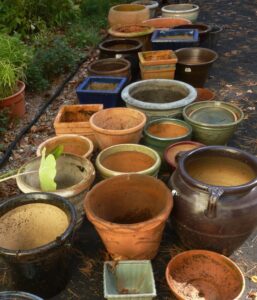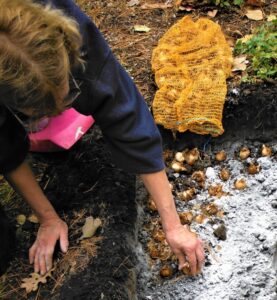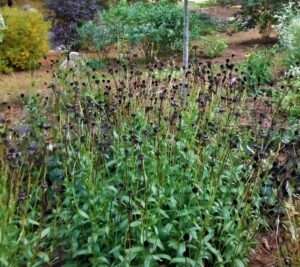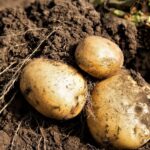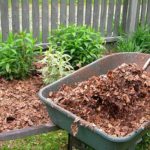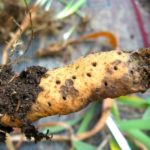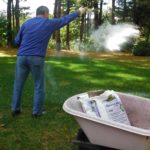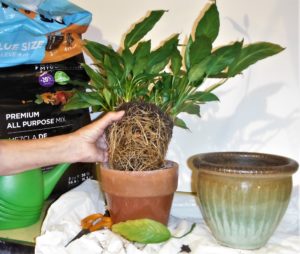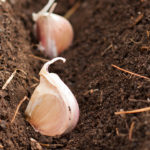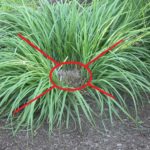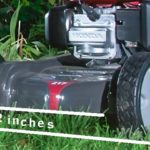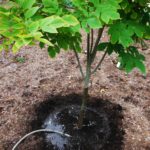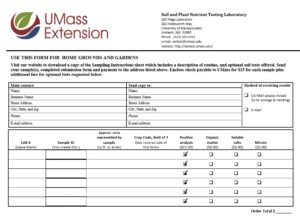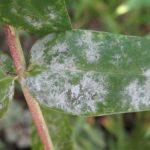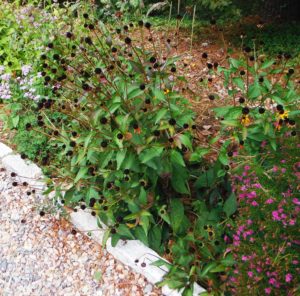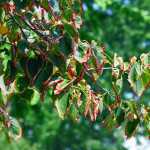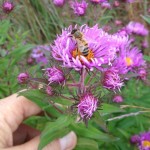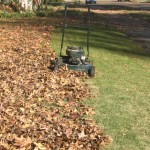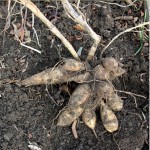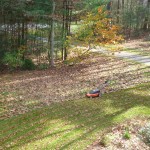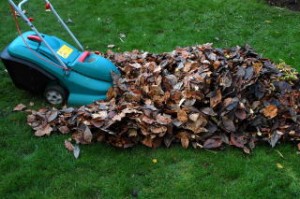Horticultural Hints – October
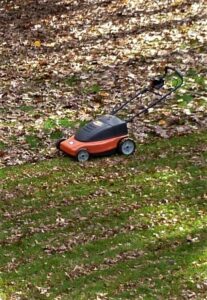 Never rake a new lawn! If you planted a new lawn this fall or over-seeded an existing one, the roots are still very small and not very strong. Raking the lawn will pull up the grass with the leaves. But if leaves are left in place, they could smother the new grass. So just mow it. The chopped-up leaves will decompose over the winter adding nutrients to the soil to feed your grass. Old lawns also benefit from mowing rather than raking.
Never rake a new lawn! If you planted a new lawn this fall or over-seeded an existing one, the roots are still very small and not very strong. Raking the lawn will pull up the grass with the leaves. But if leaves are left in place, they could smother the new grass. So just mow it. The chopped-up leaves will decompose over the winter adding nutrients to the soil to feed your grass. Old lawns also benefit from mowing rather than raking.
If you absolutely must remove the leaves, mow them into a grass catcher. The chopped leaves make an excellent winter covering for garden beds and especially around newly planted trees and shrubs.
Cleanup time. Vegetables and flower beds need a thorough clean-up this month. Remove all old foliage. Bag any diseased or insect-infested material and send it to the dump. Taking these actions now allows your plants to get a fresh start next spring, without the risk of infection from this year’s problems. ‘Clean’ foliage should preferably go into your compost bin or to your town’s compost center.
Containers designed for summer need to be taken apart, cleaned and stored for the winter. The exceptions are containers that can withstand freezing weather – usually metal, wood and certain plastic and foam containers. Once cleaned, winter-hardy containers can be replanted for fall and winter color with small evergreens, ornamental kale, colorful grasses and perennials such as Heuchera. Remember to water planted containers into the winter because the soil in the pot will dry out on sunny days.
In the vegetable garden. Some vegetables will survive light to moderate frosts. Spinach can tolerate a light frost. Members of the cabbage family such as kale and Brussels sprouts taste sweeter after expose to frost. Root crops including parsnips, salsify and even carrots and turnips can be left in the ground for later harvests, especially if protected by a light covering of straw or chopped leaves.
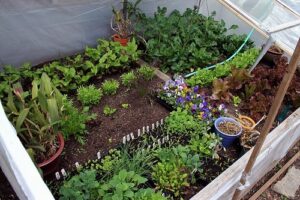 If you have a cold frame, lettuce, spinach, beets, kale and other cold-tolerant vegetables can be grown into the winter. Cold frames can consist of as little as a well secured tent of clear plastic, or as fancy as ones with heat sensors that automatically raise the lid when the sun or warm days make it too hot inside. It makes a special meal when some of your Thanksgiving or Christmas dinner can be picked fresh that morning.
If you have a cold frame, lettuce, spinach, beets, kale and other cold-tolerant vegetables can be grown into the winter. Cold frames can consist of as little as a well secured tent of clear plastic, or as fancy as ones with heat sensors that automatically raise the lid when the sun or warm days make it too hot inside. It makes a special meal when some of your Thanksgiving or Christmas dinner can be picked fresh that morning.
Spring bulbs now! If you haven’t purchased your bulbs yet, grab your phone (or computer) and get your order in before they run out of choices. Plant tulips now and daffodils at the end of this month when the soil is cooler. If you have a problem with deer or rabbits eating your bulbs, keep in mind that hyacinths, like daffodils, have an irritating sap that convinces most browsers that one bite is more than enough. Top bulbs with a layer of lime –it’s good for the bulbs and irritating those who are looking for something to eat!
Your tulips should be in the ground toward the beginning of the month, and small bulbs such as crocus, snowdrops, and grape hyacinth should be going into the ground by mid-month. Hold off planting daffodils until later in the month. To keep squirrels and other varmints from digging up and eating your bulbs, dust them with lime as you put them into the ground, and then add a layer of lime on top of the planted area. The lime interferes with smelling the bulbs, and is an important in ‘sweetening’ the soil for these plants that come from a part of the world with much less acidic soil. If you have very aggressive rodents, add hot pepper or chili powder to bulb coating.
Small bulbs – chinodoxia, crocus, grape hyacinths and others – should be planted in clusters along sidewalks or driveways where they can be appreciated up close. Some of the small bulbs such as galanthus (snowdrops) and scilla (squill) will naturalize in grassy areas providing color in early spring. Larger bulbs make a wonderful start to many beds where they bloom before the perennial flowers come up and deciduous shrubs leaf out. Their yellowing foliage will be hidden later under the new foliage of the perennials.
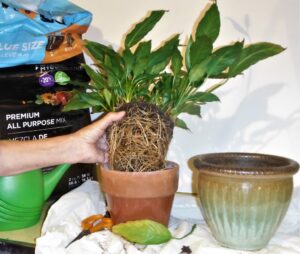
Houseplants that summered outdoors will likely have root systems that need to be trimmed before re-potting
Last call for houseplants. It has been cold outside and your houseplants are not happy. Clean them up, repot (if they have outgrown their old container over the summer) and check for any uninvited occupants. It is also a good time to prune them back into shape if they have been growing too vigorously, or to divide them to share with friends. They may be unhappy as they adjust to the lower light and dryer conditions of your home. While they need water, be careful not to overwater them. Hold off fertilizing them for now.
Cleaning up the perennial bed doesn’t mean cutting to the ground. I used to cut down all my perennials in October, but no longer. I now leave up the flower stalks with seed heads for the birds. Migrating birds appreciate the food. And it is vital for those species that over-winter in New England. In addition to less work for you, the birds make your garden a more interesting place throughout the winter. Always vigorously clean up any plant that has battled disease this year. Again, you’ll save yourself work and enjoying your garden more in the spring.
Gardening isn’t always determined by the calendar. Wherever you live, that ‘first frost date’ is based on averages (a light, mid-September frost may well have put an end to tomatoes, peppers and other warm-weather crops). If sub-40-degree weather is forecast, complete your harvest of any tender vegetables – they’ll turn to mush overnight. Then, turn your attention to harvesting, cleaning and storing your remining cool-weather fresh produce.
Remove potatoes before there’s a hard frost. Dig them out carefully and then brush off soil, but do not wash them before storing. And keep them out of the light. Potatoes do best if allowed to cure for a couple of weeks in a cool, dark place. Place newspapers under them while the skin hardens. Do not try to store any that have nicks or bruises, use them immediately.
Begin to harvest your final round of root crops. Carrots, beets, kale, spinach and radishes that you sowed as the warm weather crops were removed in August and early September should be ready for the dinner table now. They are generally frost hardy and usually can be left in the ground into November. Cover them with light cloths if a subfreezing night is forecast. Serving fresh vegetables from your own garden is one more thing to be thankful for on Thanksgiving.
Autumn leaves are spring nutrients. Mow leaves into the lawn this fall and be rewarded with healthier soil for the lawn next spring. If you use a bag attached to the mower to catch the chopped leaves, spread those chopped leaves as a mulch around trees and shrubs, and also in your perennial beds. The leaf-grass mix can also be added to the vegetable garden or, of course, your compost pile. Healthy leaves in garden beds can be left in place now, or, if you are a neatnik, rake leaves off beds, chip them up by running over the leaves repeatedly with your mulching mower, and return them to the beds. They will return the nutrients to the soil over the winter. If you are into neither mowing nor raking, spread a layer of compost over the garden beds and let Mother Nature do all the work of breaking down your leaves.
Dig and divide overgrown summer bloomers. Siberian iris with dead centers will benefit from the division. On bearded iris, look for any pinholes in the tubers. These indicate iris borers and mean a quick trip to the garbage. Healthy plants can be divided and replanted either in your garden or as gifts for friends. For tubers (dahlias), bulbs (caladiums), rhizomes (cannas) or corms gladiolus), they need to be gently lifted, then allowed to dry out of the sun. Carefully remove most of the dirt and check for insect or disease damage. Store healthy ones in paper bags in a cool dry place.
Lime time. Lime your lawn and garden this month. Rain, freezing and thawing, and snow melt all help to get the lime down into the soil before the spring growing season begins.
Re-potting season. October is the month to re-pot any house plants that have outgrown their container. Never go up more than one or two inches (for very large plants) in pot size when repotting. Remove any rotten or mushy roots. Pry apart matted or circling roots, and cut off those that are too compacted. Doing this ensures so the remaining roots will reach out into the new soil.
When re-potting, start with a coffee filter (or similar) over the pot’s drain hole to contain the soil, then add a layer of soil. Hold the plant at the level you want it to sit and add soil around it to stand it upright (with large plants you may need an assistant). Firm the soil but do not pack it down. Water thoroughly until it runs out the bottom. Set the container aside and add more water until you are certain the entire pot is wet. Use a pot saucer to catch any overflow and place the plant in its new home.
Give yourself a spring surprise. Plant hard-neck garlic, point up, after a frost late this month for a bumper crop next spring. Plant each clove separately, and top with a fresh layer of compost. Mulch with six inches of straw or pine needles in November to encourage continued root growth.
Plant seeds that need winter chilling like bachelor buttons and milkweed now. Would you like more butterflies? Plant swamp milkweed now. That dismal name disguises a plant with a lovely pink flower with a wonderful scent. And, later in the season, swamp plant will be visited by many butterflies, including our endangered Monarchs for which the milkweed is required to produce the next generation.
Divide any perennials with a dead center. In some plants such as irises and grasses, the centers die as the plant grows. Cut the perennial into four or more pieces, discard the old center and replant. Next year, you will have more plants to enjoy or share.
Cool weather is a great time to turn the compost bin. Once it’s turned, put new additions on the bottom and the older, partially composted material on top. Next spring your work will provide more compost to enrich your garden beds. What goes to the compost bin? Any clean plant material, including lettuce that has turned bitter, carrots that have gotten woody, annual flowers that are at the end of their lives.
Keep mowing, with the mower set to two inches for as long as your grass keeps growing. Mow leaves into the lawn. Mowing saves you the task of raking and, by chopping leaves into small pieces, they will break down over the winter. It’s a virtuous cycle – putting vital nutrients back into the soil, for the grass and surrounding trees for the coming season.
Do NOT rake leaves from under shrubs. Those leaves act as a mulch protecting the bush’s root over the winter. Moreover, a number of beneficial insects winter over in those leaves. Once you rake them, cart them away or chip them, you’ve removed insect friends from your garden.
Make notes on your successes and failures. Every year I try to grow plants that have failed in the past… and I often have success. Was that initial failure your fault or a bad combination of weather and animal attack? Did you go away and miss watering when it got very hot? Did a helpful friend overwater? Did you not choose the right site for the plant? A few notes will help you remember what happened, and perhaps encourage you to try again.
Leaves are gold, even if they are red. Save yourself work, improve the soil under your lawn and make the local town dump (or ‘transfer station’) happy. Don’t rake your leaves; mow them into your lawn. All the nutrients to grow those leaves came out of the soil under your lawn and around your property. If you mow over them, you will cut the lawn and chop up the leaves. You may still see them on the ground in the fall. But before spring arrives they will have broken down and become part of the soil—with all the nutrients that the lawn and trees need. Collect leaves when clearing off patios and driveways. Chop them up as well and put them around shrubs or over flower beds to add food to their soil too. If you run out of uses, put chopped leaves into a compost pile as a resource for next spring. Leaves are too valuable to throw away.
Dealing with the after-effects of a summer drought. No matter how bad your lawn looks after a summer of no precipitation and water bans, the grass will come back after the winter snows or even autumn rains. Unless serious rains return very soon, this is not the time to try to rehab your lawn.
If your town allows limited watering, use that water on new plantings – and especially on trees and shrubs. Perennials don’t need water after they have died back and shut down for the winter, but trees and shrubs do. Their roots cannot take up water when the ground is frozen. They need to fill their trunk and branches with water before winter in order to survive the season’s drying winds. If we don’t get several inches of rainfall in October and November, it’s up to you to give them several big drinks. The best way is to place a hose into the tree’s well, allow it to fill with water, and then slowly soak into the ground. No well around your tree? Make one with compacted soil or mulch, or use a “tree gator”; a device that surrounds your tree and, after it is filled, allows the water to slowly seep in the root zone.
What you can do for your lawn now. If you haven’t had a soil test in the last two years, get one done now. If you’re in Massachusetts, you can download an order form from the UMass Soil Lab here. For other areas of the country, Google your state university and ‘soil testing service’ or ‘county extension service’. Why do it now? In the spring there can be a long wait for results, but now the lab gets sent fewer tests and you have more time to follow the recommendations. The one number I always look for in the autumn is the pH of the soil (how acidic it is). In New England anything lower than about 5.5 isn’t good. Put lime down now and it will take effect by next spring when everything starts growing again.
Clean up gardens, and save something for the birds. Most garden plants look pretty tired as we enter October. Cut down any that are unattractive or diseased. Monarda (bee balm) and phlox are highly susceptible to mildew (even this year) and look terrible by now. Send them to the dump.
When you clean up your flower beds, leave some of the seed heads to feed the birds. Sunflowers are obvious choices, but plants such as rudbeckia (black eyed susans) and coneflower (echinacea) will attract birds to your yard. Keep water available for the birds all winter if possible. They need it as much as they need food throughout the winter.
Hints for autumn following a dry summer. How dry I am… is probably what most of your trees and shrubs, and perhaps your perennials are saying. At the same time, many trees show damage particularly at the top where the leaves are dropping prematurely. Shrubs are similarly distressed.
Use your water (particularly if you are in a town with watering restrictions) to help your trees and shrubs. Winter is a desert for plants. Once the ground is frozen there will be no water available to take up. If your trees and shrubs cannot fill their roots and limbs with water during the autumn, they will suffer damage or die. Lawns naturally shut down when dry and recover quickly once the rains begin. Keep watering the woody plants until the ground freezes in December if we don’t get lots of rain through October and November.
Cleaning up the vegetable garden. You may not have started harvesting winter squash and you may still have lots of greens and leaf vegetables growing, but it’s time to start cleaning up the vegetable garden. Because a disease called ‘late blight’ was a problem this year, pull up and bag tomato plants (once they have stopped producing) and then pick up all the dropped fruit. Like the plant, the fallen tomatoes can harbor disease and get your garden off to a bad start next year. These go to the trash, not the compost heap. Be aware that corn borers can overwinter in corn stalks. If they were a problem this year, don’t compost the stalks
Healthy plants should be pulled and placed in your compost bin or heap. If you take a few minutes to cut up larger plants, you will speed the composting process. After you have cleaned the garden, turn the compost heap. This puts the new material into the heart of the pile where the bacteria can get to work. It also supplies the oxygen that the microbes need to do their work.
Careful out there! Early autumn is when many wasp, bee and hornet populations are at their peak. And, with less food available, they are more likely to come in contact with humans. Bees, particularly the American native bees, have suffered huge population losses in recent years. Do not use any herbicides or pesticides that are not absolutely necessary in your garden. While no one chemical is the culprit, many scientists now believe exposure to multiple chemicals is behind this population collapse. And one out of every three bites of food you take is there because it was visited by a pollinator.
Pruning rule of thumb. Do not cut back plants that are still green and growing until the leaves begin to change color—they are still putting food in the roots for winter. And no pruning trees and shrubs until after they have gone dormant for the winter. Any cuts now might encourage growth which will not have time to harden off and will die during the freezing temperatures. Unless they have been damaged, never prune spring bloomers until they have bloomed in the spring.
Button up your overcoat. After you have cleaned up your gardens, spread an inch of compost or a layer of fresh organic mulch over them. The compost will work its way into the soil, revitalizing it for the spring growing season by adding nutrients and organic matter to the soil. Most plants that die in the winter do so not from the cold but from having their roots exposed as the soil freezes and thaws. One to two inches of compost or mulch can help keep them warmer until the soil freezes and then help keep those plants safely frozen until spring arrives.
Lawn Care for Spring It’s not too late to do a world of good for your lawn. Go to https://soiltest.umass.edu/ for information on how to send in a sample for testing. Based on the numbers UMass Ext provides to tell you what the soil needs, add lime and fertilizer now. Fertilizer will strengthen the roots and lime is vital to keep the pH of the soil in an optimum range for the growth of grass. Mowing fallen leaves instead of raking or blowing, adds nutrients and organic material to the soil at no cost and no extra work for you.
Make two piles. Much of the region has now been touched with frost and the tomatoes and marigolds, squash and petunias have departed. It is time to pull those plants that are finished and put them in two piles. Pile one is for the compost: no disease? no serious insect infestation? then compost it. Pile two is anything that is diseased or with insects eggs possibly present and certainly for any weeds with seeds that you pull up now. Pile two should be headed for the dump, or a burn pile. Separating the good and the bad now will save you work in next year’s garden. Because of a bad infestation of blight on almost everyone’s tomatoes this year, be certain to remove the fallen fruit from the vegetable garden along with the plants.
Bulbs In and Out. Begin planting spring bulbs now. Tulips should be going in the ground, but wait to plant daffodils until the soil temperature is lower. Put all bulbs at the full recommended depth. For most tulips, that is six inches below the soil line, for daffodils, at least eight inches. Smaller bulbs may only need to be four inches down. Don’t skimp on any of the holes you dig if you want the bulbs to bloom for many years to come. Put a small amount of lime on top of each bulb and when you close the whole, dust the area with more lime. This helps to prevent squirrels and rodents from sniffing out the bulbs below the surface and digging it up as soon as you leave the garden.
Also, it is time to dig up tuberous begonias and dahlias. Gently shake off the excess dirt and dry the bulbs in a garage or on a covered porch. Store them for the winter in a cool, dry place, packed in sand or vermiculite to keep them from drying out too much.
Lawns. Take “rake the lawn” off of your “to-do” list. Instead, mow your lawn with a mulching mower. Chopping up the leaves and leaving them in place is a natural way of adding organic material and nutrients to the soil. The leaf bits will break down and disappear over the winter. Cornell University says that even 16 inches of autumn leaves on your lawn will readily decompose over the winter if properly shredded by your lawnmower.
If you like raking, create a large pile and then repeatedly run your mower through it. The shredded leaves make great winter mulch for flower and shrub beds. These too will break down over the winter enriching the soil where they are spread.
Never rake a new lawn! If you planted a new lawn this fall, the roots are still very small and not very strong. Raking the lawn will pull up the grass with the leaves. But if leaves are left there, they could smother the new grass. So just mow it. The chopped-up leaves will decompose over the winter adding nutrients to the soil to feed your grass. Old lawns also benefit from mowing rather than raking.
If you absolutely must remove the leaves, mow them into a grass catcher. The chopped leaves make an excellent winter covering for garden beds and especially around newly planted trees and shrubs.
How long should you continue to mow? Keep mowing all lawns until the ground begins to freeze, probably later November based on recent years.
Cleanup time. Vegetables, flowers and, shrubs all need a thorough clean-up now. Remove all old foliage. Bag any diseased or insect-infested material and send it to the dump. Taking these actions now allows your plants to get a fresh start next spring, without the risk of infection from this year’s problems. ‘Clean’ foliage should go into your compost bin or to your town’s compost center.
Containers need to be taken apart, cleaned and stored for the winter. The exceptions are containers that can withstand freezing weather – usually metal, wood and certain plastic and foam containers. Once cleaned, winter-hardy containers can be replanted for fall and winter color with small evergreens, ornamental kale, colorful grasses and perennials such as Heuchera. Remember that containers will need to be watered even into the winter because the soil in the pot will dry out on sunny days.
In the vegetable garden. Some vegetables will survive light to moderate frosts. Lettuce and spinach can tolerate a light frost. Members of the cabbage family such as kale and Brussels sprouts taste sweeter after expose to frost. Root crops including parsnips, salsify and even carrots and turnips can be left in the ground for later harvests.
 Spring Bulbs now! If you haven’t purchased your bulbs yet, get to gardens centers while the selection is still good and supply plentiful. Plant tulips now, and daffodils at the end of the month when the soil is cooler. If you have a problem with deer or rabbits eating your bulbs, keep in mind that hyacinths, like daffodils, have an irritating sap that convinces most browsers that one bite is more than enough.
Spring Bulbs now! If you haven’t purchased your bulbs yet, get to gardens centers while the selection is still good and supply plentiful. Plant tulips now, and daffodils at the end of the month when the soil is cooler. If you have a problem with deer or rabbits eating your bulbs, keep in mind that hyacinths, like daffodils, have an irritating sap that convinces most browsers that one bite is more than enough.
Plant small bulbs – chinodoxia, crocus, grape hyacinths and others – in clusters along sidewalks or driveways where they can appreciated up close. Some of the small bulbs such as galanthus (snowdrops) and scilla (squill) will naturalize in grassy areas providing a colorful early spring. Larger bulbs make a wonderful start to many beds where they bloom before the perennial flowers come up and deciduous shrubs leaf out. Their yellowing foliage will later be hidden under the new foliage of the perennials.
Last call for houseplants. It has been cold outside and your houseplants are not happy. Clean them up, repot (if they have outgrown their old container over the summer) and check for any uninvited occupants. It is also a good time to prune them back into shape if they have been growing too vigorously, or to divide them and share with friends.
Remember houseplants will be unhappy as they adjust to the lower light and dryer conditions of your home. While they need water, be careful not to overwater them, and hold off on fertilizer until they no longer are dropping leaves.
Clean up in the vegetable garden. Dead leaves from tomatoes and squash plants, bean vines and corn stalks provide a paradise for overwintering bean beetles, squash and corn borers, and many other pests. Cut them down and remove them from the garden now. Do not compost because many eggs and diseases will survive the home composting procedure. Parsnips and salsify will improve over the winter in frozen soil, but carrots, beets and turnips need to be harvested before a severe frost hits.
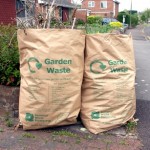
Allowed to remain on the ground in your garden, diseases on leaves will over-winter to caused problems in 2013
After the clean-up is completed, dig a trench and add half-composted manure mixed with garden soil. You are now ready for planting peas next spring as soon as the soil has thawed and dried out a bit, without needing to worry about digging in wet soil. While you are at it, prepare a second shallow trench in which you can plant garlic over the winter. Place the cloves pointed end up and cover them with soil. Put a light mulch on until you see the green sprouts appear. Add a heavier mulch as the ground freezes. They will be ready to harvest next summer.
Clean up in the flower beds. Once again, take away those plants affected with disease or insect infestations. [See my article on impatiens downy mildew—or why your impatiens died this year here] Diseases and insect eggs often will survive in the soil and plant debris, so a fall clean-up is vital for a good garden next year. Remove excess leaves from flower and herb beds since they can harbor insects or keep the stems of plants such as lavender wet causing rot.
The greatest danger when planting spring bulbs is too much moisture. If your yard does not drain well, plant the bulbs in raised beds. The second greatest danger is rodents digging up and eating the bulbs. To keep them at bay, place a small amount of lime powder (not the pellets) in the hole after first adding an inch of soil. When the hole is filled, water well, tamp the soil down lightly and then place a heavy coating of powdered lime over the entire area. Rodents cannot smell the bulbs underneath and will not bother them.
Houseplants. Your houseplants are probably in shock now. Since coming inside, light levels have dropped and as the weather cools and the furnace comes on, the humidity levels will drop dramatically. Cut back on watering and stop all fertilizing until the plants have adjusted to their new environment. Keep a careful eye on plants for any insects that have hitched a ride inside. Outdoors, they had enemies (good insects) to keep them in check; inside the care you provide is the only defense you house plants have.
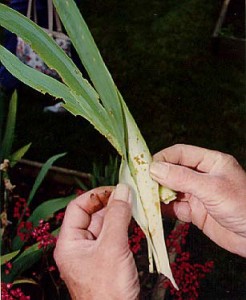 Pace yourself! Garden clean-up is something best done in stages. It saves the gardener’s back and keeps attractive plants going longer. It’s also common sense. For example, remove annuals now if they are overgrown or as soon as they are touched by frost. Remove any flowering perennials whose best days are past. Cut down foliage that has become unattractive due to disease or insects. And, as for that diseased foliage, don’t compost it, bag them for the trash. You don’t want it around your garden.
Pace yourself! Garden clean-up is something best done in stages. It saves the gardener’s back and keeps attractive plants going longer. It’s also common sense. For example, remove annuals now if they are overgrown or as soon as they are touched by frost. Remove any flowering perennials whose best days are past. Cut down foliage that has become unattractive due to disease or insects. And, as for that diseased foliage, don’t compost it, bag them for the trash. You don’t want it around your garden.
Speaking of bagging… Gladioli and dahlia tops should be bagged and discarded along with corn and sunflower stalks. They can all harbor corn borers over the winter. Even if they don’t look diseased, composting iris foliage isn’t a good practice. Iris borers lay their eggs on the iris leaves, and the eggs overwinter quite nicely. So, cut down and remove the iris foliage from your garden each fall.
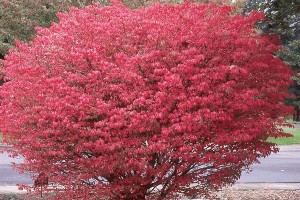
Euonymous alatus – burning bush – is invasive in New England. This is a good time of year to dig it out.
Go native. When you admire the bright red of burning bush (euonymus alatatus, shown at right) this fall, keep in mind it is an invasive that is taking over our woodlands, pushing out the native plants that birds and other wildlife depend on. In the woods it is usually pink instead of red and scrawnier because it is growing under a canopy of trees. But it is growing and spreading nonetheless. Removing the one in your yard is the first step to removing them from the environment. Need a replacement? Native shrubs including the fothergilla, itea, blueberry and viburnum provide great color with a clear conscience.
Add a garden the easy way. Thinking of adding a new vegetable garden, flower or shrub bed to your property? Don’t dig, cover. Mark out the area of the new garden, place cardboard around the edges, then put down 6 to 8 sheets of newspaper over the entire area. Cover it with 6 to 8 inches of chipped leaves, compost or soil. By spring the grass underneath will be dead. Next Spring, do not remove the soil or mulch but, rather, plant directly into it. Your bed will be lower as the material settled. You can edge with bricks, timbers or by just removing a narrow trench of grass around the edge. This keeps the grass from re-colonizing the new bed.
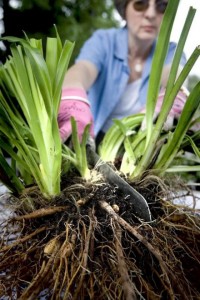 Dig and divide overgrown summer bloomers. Siberian iris with dead centers will benefit from the division On bearded iris, look for any pinholes in the tubers. These indicate iris borers and mean a quick trip to the garbage. Healthy plants can be divided and replanted ,more for your garden or gifts for friends.
Dig and divide overgrown summer bloomers. Siberian iris with dead centers will benefit from the division On bearded iris, look for any pinholes in the tubers. These indicate iris borers and mean a quick trip to the garbage. Healthy plants can be divided and replanted ,more for your garden or gifts for friends.
It’s time to get your tender bulbs out of the ground. Whether they are tubers (dahlias), bulbs (caladiums), rhizomes (cannas) or corms gladiolus), they need to be gently lifted, then allowed to dry out of the sun. Carefully remove most of the dirt and check for insect or disease damage. Store healthy ones in paper bags in a cool dry place.
Take advantage of sales at local nurseries to buy shrubs and trees. Remember to loosen root balls, and plant in saucers not teacups, holes wider than deep to allow roots to quickly spread. Water frequently until the ground is frozen because the roots will keep growing after the leaves have dropped.
Love fall color, but hate to rake? Then don’t! But don’t allow leaves to smother your grass, either. Mow those leaves with a mulching blade on the mower. Early in the season you won’t even notice the now- shredded leaves between grass blades. As the season progresses you may see some chopped leaves. Up to six (!) inches of leaves can be mower-mulched and left in place on the lawn. Ninety-nine percent of those leaves will break down into compost before Spring, improving your soil, giving you a richer, better lawn next year.
If you can’t bear the thought of not raking, or you prefer to mower-mulch and bag your leaves, don’t take them to the dump or leave them on the curb. Make use of those free nutrient-rich organics by putting them in a compost bin, or spreading mulched leaves over flower and shrub beds. Once mulched they won’t blow, they’ll look attractive and they’ll break down to improve the soil. Either way, the leaves stay out of landfills and make your property nicer next year.
Do you have mushrooms in your lawn? Don’t worry, they are a sign of something right. The presence of mushrooms means there is organic matter breaking down under the lawn. In other words, new soil is being made. If you don’t like the look, mow or kick them over, they are harmless to the lawn but, like all wild mushrooms, should be considered poisonous if eaten by humans.
